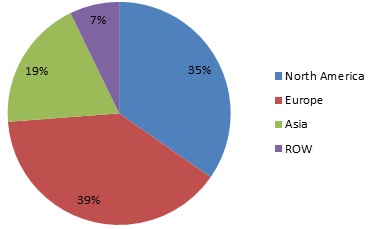High temperature insulation (HTI) products accords high compressive
strength and low shrinkage at high temperatures; and thus offer a
cost-effective energy management solution for industrial processes. The global HTI products market - defined as insulation products with
maximum operating temperature exceeding 1000° C - is witnessing
tremendous growth due to the increasing awareness about the energy
saving, cost effectiveness and emission reduction offered by these
products, and industrialization of emerging economies.
The high temperature insulation market (defined as
insulation products with maximum operating temperature exceeding 1000°
C) is estimated at $2.7 billion in 2011. Industrialization of emerging
economies, the need for energy conservation and emission reduction, wide
range of applications across petrochemical industry, and development of
low bio persistent products are the major market drivers and
opportunities and will influence the market size to grow by compounded
annual growth rate (CAGR) of 5.4% during 2011 – 2016.
High Temperature Insulation Market, by geography, 2011 (% Share)

Source: MarketsandMarkets Analysis
The geographical segmentation shows that Europe holds
the largest share in the high temperature insulation market, generating
39% of the total revenue. The saturated European market is closely
followed by another saturated market i.e. North America. The fairly
nascent Asian market, however, is the fastest growing market for the
industrial high temperature insulation applications. Saturation in the
European and North American markets has resulted in a shift of focus
towards the emerging Asian markets. Steep costs of the insulation
products in these saturated market has also given a boost to the exports
from the Asian subcontinent. Asia and other emerging economies world
over offer the highest growth opportunities for high temperature.
The major applications of HTI products are petrochemicals, cement,
glass, ceramics, refractory, aluminum, powder metallurgy, and iron and
steel industry. Petrochemicals currently hold a 30% share of the overall
HTI market, and are expected to continue being the largest application
market through 2016. Glass forms the next largest application segment,
holding a 14% share of the overall market currently. Most of the
applications require insulation at maximum temperature ranging from
1000° C to 1300° C. HTI products falling within this temperature range
account for 65% of total HTI market revenue.
The global HTI products market is estimated to grow from $2.7 billion in
2011 to $3.5 billion in 2016. While Europe led the global HTI market in
2011 with a 39% share, India, China, Russia and Middle East have
registered dynamic growth rates. Petrochemical industry is the largest consumer of
the HTI products, accounting for nearly 30% of the market revenue in
2011. Glass is the second largest in terms of revenue share i.e. 14%
followed by ceramic with 12.3% in 2011. In terms of operating
temperatures for the HTI product, the market is broken down into 5
segments, covering a temperature range from 1,000° C to 1,700° C and
beyond. The products catering to temperature range of 1,000° C to 1,300°
C are the highest revenue contributors in 2011, although the products
for 1,700° C and above temperatures show promising growth in the years
to come.
On the basis of properties, high temperature
insulation market can be divided into ceramic fibers, calcium silicate,
insulating firebricks (IFB) and others. Out of the different HTI
material categories, ceramic fibers are the most widely used material,
and hold nearly 60% of the market in 2011. The high temperature
resistance, superior tensile strength and flexibility are reason driving
the demand for this material. IFB find favored usage in the furnace
applications and occupies the 20% of the market share in 2011. Newer
materials like aerogel, bio-persistent insulation materials, etc. occupy
a small share in the market, however, show the promise for the period
from 2011-2016.
No comments:
Post a Comment